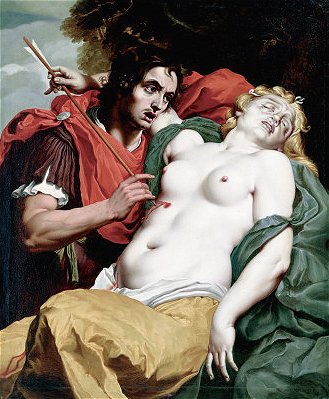 |
|
CEPHALUS GRIEVING OVER THE DYING PROCRIS
Abraham Janssens Flemish 1575-1632
SN 11035 Oil on Canvas About
1610
by Robert Anderson
ARTIST
Abraham Janssens was the premier painter in Antwerp before Rubens
returned from Italy after 1600. He was highly esteemed as a painter of historical,
religious and mythological subjects, often on a large scale, derived principally from
antique sculpture and the art of Michelangelo, Raphael and others. He suffered from the
inevitable comparison with his contemporary and formidable rival, Rubens, whose brilliance
somewhat eclipsed his own achievements.
The limitation of Janssens' source material is noteworthy: for secular
themes, for example, it is virtually confined to Ovid'd Metamorphoses. Janssens also
tended to lengthen his figures' lower limbs - which accented the perspectival distortion
due to the hight at which the work would be hung - and the superfluous drapery which bore
little relation to the figures underneath. All this is in contrast to Rubens' balanced
compositions, which were perspectively and anatomically correct.
Janssens' achieved his best work when he could rely, for the
composition as well as the subjet matter, on a great predecessor. |
He seems constantly to have drawn from the same limited sculptural repertory. The total
open, systematic way in which he borrowed from these sources and the conventional way in
which he combined them set Janssens apart from his Netherlandish contemporaries.
There were two genres in which Janssens made a lasting personal
contribution to the art of his time: allegorical scenes with a limited number of figures
in close-up, and contemplative scenes from the Passion, in which the meekly suffering
Christ, as an objet of devotion, appears almost palpably to intrude into the space of the
spectator.
SUBJECT
This is the scene showing an episode in one of the great love stories
of ancient myth. Cephalus and Procris were recently married when Aurora, goddess of dawn,
fell in love with Cephalus, who rejected her. Aurora retaliated by planting in him seeds
of suspician concerning Procris' faithfulness. To test his wife, Cephalus disguised
himself, tried to seduce her and nearly succeeded. Procris in shame, fled to join Diana,
who gave her two gifts for her husband: a hunting dog and a magic spear that never failed
to find its mark.
A faun who was in love with Procris told her that he had heard Cephalus
talking to a secret lover. To discover the truth Procris followed her husband into the
forest and hid in some bushes. Cephalus, hearing a rustling of leaves, threw his spear and
killed his wife. Here Janssens concentrates on the turning point of the tragedy as
Cephalus realizes with horror the consequences of his jealousy as he movingly and
pathetically receives Procris' dying embrace.
In some versions of the myth, Diana forgives Cephalus and brings
Procris back to life.
PAINTING
This painting shows the harshness and sculpturability of Janssens'
style which was replaced by Rubens' softer and more tender modeling of human flesh ( as in
Pausias and Glycera). Here Janssens models the dying Procris in a pose reminiscent of
Christ in Michelangelo's Pieta.
This borowing not only reflects Janssens' admiration for Michelangelo,
but is also relevant to the story: not only is Cephalus' grief a classic reminisence of a
lamentation, but like Christ, Procris was resurrected from the dead thanks to the grace of
God.
This is a recent addition to the collection, purchased in 1999 with
funds from the Investment Art Fund.
Note : The painting has been criticised by a well known local critic,
Joan Altabe, as portraying the dying Procris' nudity needlessly - not as a legitimate
device to convey the idea of vulnerability but "to celebrate the age-old fondness for
painting nude women in compromising positions".
HISTORICAL CONTEXT
Janssens' position as one of the most important history painters in the
Netherlands was challenged by Rubens' return to Antwerp in 1608. The former's fame was not
immediately eclipsed, however: between 1608-9 and 1618-19 both artists supplied paintings
for well known ensembles.
That Janssens was outclassed artistically by
Rubens is not primarily explained by the opposition between the former's retrospetive
classicism and the dynamic novelty of the latter's Baroque style. It was due to
Janssens'inability to transpose his artistic sources while Rubens was skillful in fusing
the manifold borrowings into a new organic unity in his work.
ringlingdocents.org
|
